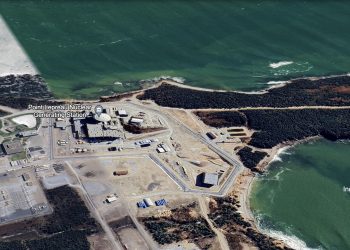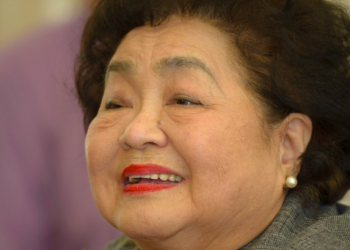In the public imagination, nuclear power for electricity and nuclear weapons are entirely separate issues. Because Canada is not a nuclear weapons state, Canada’s nuclear power reactors are thought to be unrelated to weapons of mass destruction, and its nuclear technology exports are considered ‘peaceful.’
Yet this week marks the 50-year anniversary of one day in May when Canada’s ‘peaceful’ nuclear image was shattered. On May 18, 1974, India shocked the world by conducting a test A-Bomb explosion it called ‘Smiling Buddha.’ The nuclear explosive was plutonium, obtained from a ‘peaceful’ research reactor – a gift from the Canadian government in 1956.
Plutonium is not found in nature but nuclear reactors create it as a by-product. Plutonium was the explosive used in the A-Bomb that the U.S. military dropped on the Japanese city of Nagasaki in 1945, killing 70,000 civilians, half of them on the first day.
The story of India’s first A-Bomb shows that ‘intent’ is all that separates military from civilian use of nuclear technology. On that fateful day in 1974, it suddenly became clear that any country with a nuclear reactor can choose to extract plutonium from the fiercely radioactive used fuel and secretly make a nuclear bomb.
Plutonium extraction is a sensitive procedure called ‘reprocessing.’ Plutonium can also be used as a nuclear fuel. But this can only be done by first reprocessing used nuclear fuel, and this increases the risk of nuclear weapons proliferation. As the International Panel on Fissile Materials states: ‘the most important reason to be concerned about the practice of reprocessing is that plutonium can be used to make weapons.’
India’s nuclear explosion deeply traumatized Ottawa and shocked the world. U.S. Secretary of State Henry Kissinger publicly shamed Canada when he told the media that: ‘The Indian nuclear explosion occurred with material that was diverted not from an American reactor under American safeguards, but from a Canadian reactor that did not have appropriate safeguards.’ His statement conveniently ignored the fact that the U.S. encouraged India in its reprocessing technology.
India’s nuclear explosion led to a de-facto ban on commercial reprocessing in Canada by Prime Minister Pierre Elliot Trudeau following an explicit ban on reprocessing by U.S. President Jimmy Carter. The de-facto ban in Canada remains today, despite industry efforts to overturn it.
In 2022, Jonathan Wilkinson, Minister of Energy and Natural Resources, delivered ‘Canada’s National Statement on Nuclear Energy’ in Washington, emphasizing just one word, ‘peaceful’: ‘Canada began a legacy of nuclear excellence as the second country ever to produce nuclear power. Since that time, we have been actively involved in promoting the peaceful use of nuclear energy around the world.’
In 2023, Canada signed the G7 Leaders’ Hiroshima Vision on Nuclear Disarmament, committing the country to ‘prioritizing efforts to reduce the production and accumulation of weapons-usable nuclear material for civil purposes around the world.’
Despite all this, Public Safety Minister Dominic LeBlanc fronted a media event in March 2021 in Saint John, New Brunswick, that raised questions about the government’s commitment to the ‘peaceful’ atom. He announced $50.5 million in funding to the Moltex company. This grant would help Moltex develop a technology to extract plutonium from used nuclear fuel stored at the Point Lepreau nuclear site on the Bay of Fundy, to be used as fuel for a newly conceived Moltex ‘molten-salt’ reactor. If the project is successful, Moltex plans to export its reprocessing technology around the world.
Less than two months later, nine distinguished U.S. non-proliferation experts signed an open letter to Prime Minister Justin Trudeau expressing concern that by ‘backing spent-fuel reprocessing and plutonium extraction, the Government of Canada will undermine the global nuclear weapons non-proliferation regime that Canada has done so much to strengthen.’
The U.S. experts stated that Canada’s support for the Moltex technology could be used by other countries to justify their own plutonium acquisition programs and undo decades of efforts to keep nuclear weapons out of the hands of countries that might want to join the ranks of unofficial nuclear weapons states: India, Pakistan, North Korea and Israel.
In subsequent letters, the experts expressed concern that the Canadian government has forgotten the lessons learned 50 years ago with the launch of India’s nuclear-weapon program. They reminded the Prime Minister that the experience led Prime Minister P.E. Trudeau and U.S. President Jimmy Carter to oppose the separation of plutonium from spent fuel.
After India’s nuclear explosion in 1974, Canada and the United States became founding members of the Nuclear Suppliers Group that helped to ensure there has been no export of reprocessing technology to non-nuclear weapons states since. The U.S. experts stated: “It is imperative to uphold this decades-long norm of not reprocessing, lest we find ourselves in a world of many states with latent nuclear-weapon capabilities.”
Canada’s support for reprocessing now is sending the wrong signal to the world and threatening the already fragile global non-proliferation regime. Will history repeat itself?
An earlier version of this story was published by The Hill Times.
Note: a correction to the story was made after publication: Canada gave the reactor to India in 1956, not 1954 as originally stated.
Susan O’Donnell, PhD, is the lead investigator of the CEDAR project in the Environment & Society program at St. Thomas University. Gordon Edwards, PhD, is president of the Canadian Coalition for Nuclear Responsibility in Montreal.


![Radioactivity and nuclear waste under scrutiny in Peskotomuhkati homeland [video]](https://nbmediacoop.org/wp-content/uploads/2025/10/EdwardsAkagiOct52025-1-350x250.jpg)
![Poster exhibit remembers the two Japanese cities devastated by nuclear weapons [video]](https://nbmediacoop.org/wp-content/uploads/2025/10/image0-3-350x250.jpeg)






